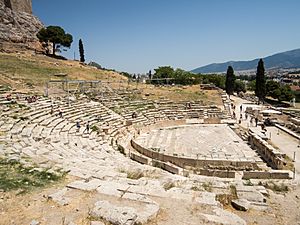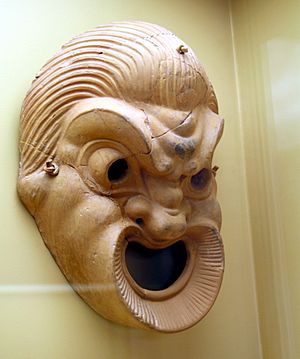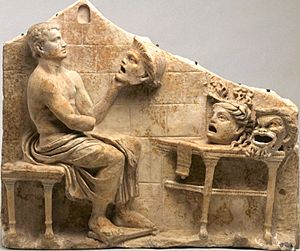Theatre of ancient Greece facts for kids
Imagine a world where stories came alive on stage, thousands of years ago! That's what happened in ancient Greece, starting around 700 BC. The city of Athens was a very important place for culture, politics, and religion. Theatre became a big part of their lives. It was especially important during a festival called the Dionysia, which celebrated the god Dionysus.
Three main types of plays became popular: tragedy (serious plays), comedy (funny plays), and the satyr play (a mix of myth and humor). Athens shared these festivals with other cities. Today, much of our modern theatre, from its words to its story ideas, comes from these amazing beginnings in ancient Greece.
Contents
The Meaning of "Tragedy"
The word "tragedy" comes from two ancient Greek words. The first is tragos, which means "goat." The second is ode, meaning "song." So, "tragedy" literally means "goat song."
This name might connect to old traditions that honored the god Dionysus. We don't know exactly how these early celebrations led to the plays we call tragedies and comedies today.
How Theatre Began
Ancient Greeks truly believed in the power of spoken words. They used storytelling to share history and myths. Many thought that spoken stories were more alive than written ones. This is why oral storytelling was so important in Greece.
The First Actors and Plays
Greek tragedy started in Athens around 532 BC. A man named Thespis is often called the first actor. He won the first theatre contest in Athens. He led special songs and dances called dithyrambs during festivals. These performances slowly changed into plays. Thespis's name lives on today; actors are sometimes called "thespians."
Theatre became very important to the Athenians. They created a big festival called the City Dionysia. This festival included competitions for playwrights. It helped bring the different parts of Athens together.
Early Playwrights and Their Stories
We don't have many plays from the earliest times. But we know names like Choerilus, Pratinas, and Phrynichus. These early writers brought new ideas to theatre.
Phrynichus was a famous early playwright. He wrote plays about myths and historical events. For example, his play The Fall of Miletus told the sad story of a city conquered by the Persians. It made the audience so sad that they cried. Phrynichus was also one of the first to include female characters in his plays. Remember, men played all the roles back then!
For a long time, plays were performed only once. They were special tributes to Dionysus. The plays we still have today are the ones that were popular enough to be performed again later.
New Ideas in the Golden Age
After Athens was rebuilt around 480 BC, theatre became even more important. This time is often called the Golden Age of Greek drama. The annual Dionysia festival held big competitions. Three playwrights would compete, each presenting three tragedies and one satyr play. Satyr plays were funny versions of myths. Later, playwrights also started submitting comedies.
Great playwrights like Aeschylus and Sophocles made important changes. Aeschylus added a second actor to plays. Sophocles then added a third. Greek plays never used more than three actors on stage at one time.
Tragedies and comedies were kept very separate. They were different types of plays and never mixed their styles. Satyr plays used serious myths but told them in a very funny way.
Theatre Changes Over Time
After Athens lost a big war against Sparta, its power lessened. Theatre began to perform older plays more often. Even though things changed, Greek theatre continued to grow during the Hellenistic period. This was the time after Alexander the Great's conquests.
During this period, a new type of play became popular: New Comedy. These were funny stories about the everyday lives of regular people. The playwright Menander is the most famous writer from this time. New Comedy greatly influenced later Roman comedy.
Building the Greek Theatres
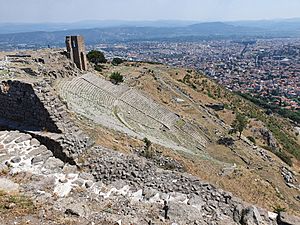
Ancient Greek cities were often built on hills. So, theatre seats were usually carved into the hillside. This created a natural viewing area called the theatron, which means "seeing place." If there wasn't a hill, they would build up earth to make seats.
At the bottom of the hill was a flat, round area called the orchestra. This means "dancing place." A chorus of 12 to 15 people performed plays here. They would sing and dance to music. Tall, arched entrances called parodoi allowed actors and chorus members to enter and exit. Behind the orchestra, some theatres had a scenic wall called the skené.
Eventually, the word "theatre" came to mean the entire performance area. This included the theatron, orchestra, and skené.
The Seating Area: The Theatron
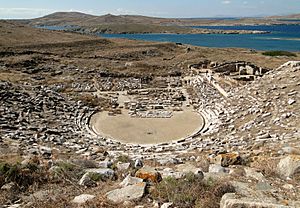
The theatron was where the audience sat. At first, people sat on the ground or on wooden benches. Later, stone blocks were used to create permanent seats. The best seats, called prohedria, were for priests and important citizens. A walkway called the diazoma separated the upper and lower seating sections.
The Stage Background: The Skene
Around 465 BC, playwrights started using a backdrop or scenic wall. This was called the skené, which is where our word "scene" comes from. It stood behind the orchestra and was also a place for actors to change costumes. Later, a stone wall called a paraskenia was added. This was a long wall with projecting sides, often with doorways.
Behind the paraskenia was the proskenion, similar to a modern proscenium. The upper level was called the episkenion. Sometimes, there was a raised platform in the orchestra called the logeion for actors to speak from. By the end of the 5th century BC, the skené was two stories high.
If a character died in a play, it was always heard from behind the skené. This was done for dramatic effect, rather than showing the death on stage. A temple was often built near the theatre, especially on the right side of the scene.
The Performance Space: The Orchestra
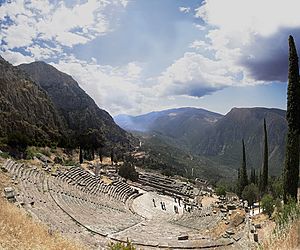
The orchestra was the circular area at the bottom of the theatron. This is where the chorus and actors performed. The word means "dancing space" because the chorus often danced. At first, it was just a flat area. Later, a raised stage was added for better viewing. This became common with "New Comedy" plays. The coryphaeus was the leader of the chorus. This person could even become a character and talk with the actors. Plays often started in the morning and lasted until evening.
Amazing Sound: Acoustics
Greek theatres were huge! They could hold up to fourteen thousand people. Physics and math were very important in their design. The builders made sure that actors' voices could be heard clearly everywhere. Even people in the very top rows could hear the performance. The Greeks had an excellent understanding of sound.
Special Stage Effects
Ancient Greek theatre used several clever scenic elements:
- mechane: A crane that could lift an actor. This made it look like they were flying. This is where the phrase deus ex machina comes from, meaning a sudden, unexpected solution to a problem.
- ekkyklêma: A wheeled platform. It was often used to bring dead characters into view for the audience.
- pinakes: Pictures hung up to create scenery.
- thyromata: More complex pictures built into the second level of the skené.
The Power of Masks
Masks were a very important part of ancient Greek theatre. The Greek word for mask was prosopon, meaning "face." Masks were used in religious ceremonies for the god Dionysus. They were also important for showing respect to the gods.
We don't have any original masks today. They were made from materials that don't last, like stiffened linen or leather. After performances, they were often given to the altar of Dionysus. But we know masks were used since the time of Aeschylus. They are a symbol of classical Greek theatre.
The chorus members also wore masks. Even though there were many chorus members, they all wore the same mask. This made them seem like one character speaking with many voices. Today, the famous comedy and tragedy masks symbolize all performing arts.
How Masks Were Made
Masks covered the actor's entire face and head, like a helmet. They had holes for the eyes and a small opening for the mouth. They also had a wig attached. These masks helped the actor disappear into their role. The mask transformed the actor as much as learning the lines did.
Mask makers were called skeuopoios, or "maker of props." Masks were likely made from lightweight materials. These included stiffened linen, leather, wood, or cork. Wigs were made from human or animal hair. The small mouth opening meant the mask didn't work like a megaphone. However, some believe masks helped voices resonate, making them sound stronger.
What Masks Did
In large open-air theatres, masks helped create strong emotions. Their exaggerated features could make an audience feel dread or panic. Masks also allowed one actor to play several different roles. This kept the audience from knowing who the actor was.
Masks helped the audience understand characters. They showed a character's sex, age, and social status. They could also show changes in a character's appearance. For example, a special mask might be used for Oedipus after he blinded himself. Unique masks were also made for specific characters, like the Furies in Aeschylus' Eumenides.
Since only two or three actors were on stage at a time, masks allowed quick character changes. All actors were men, so masks helped them play female characters convincingly.
Costumes and Clothing
Actors in tragedies wore special boots called cothurnus (or buskins). These boots had thick soles that made them taller than other actors. Actors in comedies wore thin-soled shoes called soccus (or socks). This is why dramatic art is sometimes called "sock and buskin."
Most of what we know about costumes comes from pottery paintings. Costumes and masks were made from materials that didn't last. The Pronomos Vase is a great source. It shows actors at a party after a show.
Costumes helped show a character's gender, age, and social status. Higher-class characters wore nicer clothing. Costumes were colorful and easy to see from every seat. For example, gods, heroes, and old men wore long robes called chitons that reached the floor. Powerful goddesses and women wore purple and gold. Queens and princesses wore long cloaks decorated with gold stars and jewels. Warriors wore various armor and helmets with plumes.
See also
 In Spanish: Teatro de la Antigua Grecia para niños
In Spanish: Teatro de la Antigua Grecia para niños
- List of ancient Greek playwrights
- List of ancient Greek theatres
- History of theatre
- Representation of women in Athenian tragedy
- Agôn
- Antistrophe
- Archon
- Aulos
- Chorêgos
- Chorus of the elderly in classical Greek drama
- Didascaliae
- Didaskalos
- Eisodos
- Ekkyklêma
- Episode
- Epode
- Kommós
- Mêchanê
- Monody
- Ode
- Onomastì komodèin
- Parabasis
- Phlyax play
- Sparagmos
- Stásimon
- Stichomythia
- Strophê
- Thalia (Muse)
- Theatre of ancient Rome
- Theoric fund
- Roman theatre (structure)
- List of films based on Greek drama




